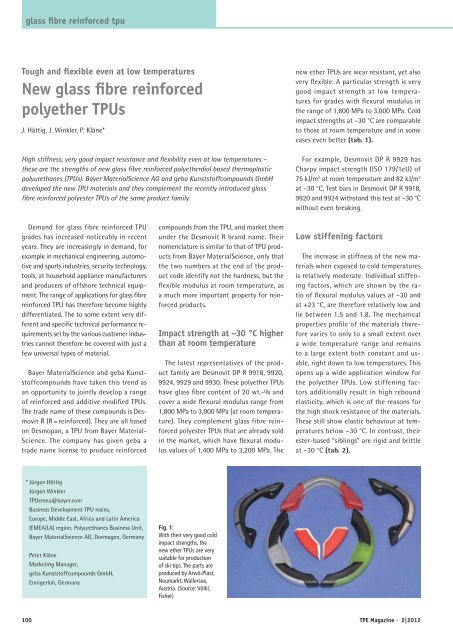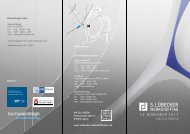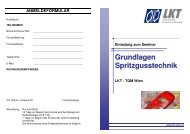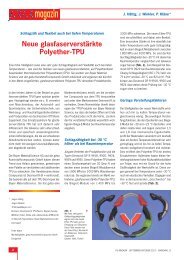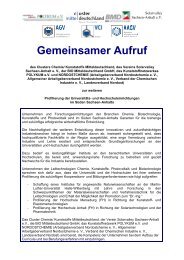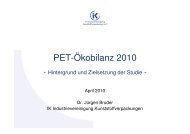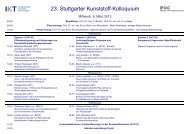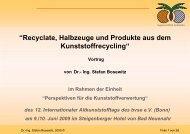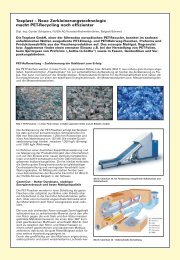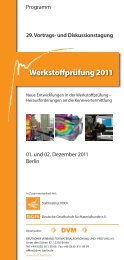New glass fibre reinforced polyether TPUs - Plasticker
New glass fibre reinforced polyether TPUs - Plasticker
New glass fibre reinforced polyether TPUs - Plasticker
You also want an ePaper? Increase the reach of your titles
YUMPU automatically turns print PDFs into web optimized ePapers that Google loves.
<strong>glass</strong> fi bre <strong>reinforced</strong> tpu<br />
Tough and fl exible even at low temperatures<br />
<strong>New</strong> <strong>glass</strong> fi bre <strong>reinforced</strong><br />
<strong>polyether</strong> <strong>TPUs</strong><br />
J. Hättig, J. Winkler, P. Kläne*<br />
High stiffness, very good impact resistance and flexibility even at low temperatures –<br />
these are the strengths of new <strong>glass</strong> <strong>fibre</strong> <strong>reinforced</strong> <strong>polyether</strong>diol based thermoplastic<br />
polyurethanes (<strong>TPUs</strong>). Bayer MaterialScience AG and geba Kunststoffcompounds GmbH<br />
developed the new TPU materials and they complement the recently introduced <strong>glass</strong><br />
<strong>fibre</strong> <strong>reinforced</strong> polyester <strong>TPUs</strong> of the same product family.<br />
Demand for <strong>glass</strong> <strong>fibre</strong> <strong>reinforced</strong> TPU<br />
grades has increased noticeably in recent<br />
years. They are increasingly in demand, for<br />
example in mechanical engineering, automotive<br />
and sports industries, security technology,<br />
tools, at household appliance manufacturers<br />
and producers of offshore technical equipment.<br />
The range of applications for <strong>glass</strong> fi bre<br />
<strong>reinforced</strong> TPU has therefore become highly<br />
differentiated. The to some extent very different<br />
and specifi c technical performance requirements<br />
set by the various customer industries<br />
cannot therefore be covered with just a<br />
few universal types of material.<br />
Bayer MaterialScience and geba Kunststoffcompounds<br />
have taken this trend as<br />
an opportunity to jointly develop a range<br />
of <strong>reinforced</strong> and additive modifi ed <strong>TPUs</strong>.<br />
The trade name of these compounds is Desmovit<br />
R (R = <strong>reinforced</strong>). They are all based<br />
on Desmopan, a TPU from Bayer Material-<br />
Science. The company has given geba a<br />
trade name license to produce <strong>reinforced</strong><br />
* Jürgen Hättig<br />
Jürgen Winkler<br />
TPUemea@bayer.com<br />
Business Development TPU resins,<br />
Europe, Middle East, Africa and Latin America<br />
(EMEA/LA) region, Polyurethanes Business Unit,<br />
Bayer MaterialScience AG, Dormagen, Germany<br />
Peter Kläne<br />
Marketing Manager,<br />
geba Kunststoff compounds GmbH,<br />
Ennigerloh, Germany<br />
compounds from the TPU, and market them<br />
under the Desmovit R brand name. Their<br />
nomenclature is similar to that of TPU products<br />
from Bayer MaterialScience, only that<br />
the two numbers at the end of the product<br />
code identify not the hardness, but the<br />
fl exible modulus at room temperature, as<br />
a much more important property for <strong>reinforced</strong><br />
products.<br />
Impact strength at –30 °C higher<br />
than at room temperature<br />
The latest representatives of the product<br />
family are Desmovit DP R 9918, 9920,<br />
9924, 9929 and 9930. These <strong>polyether</strong> <strong>TPUs</strong><br />
have <strong>glass</strong> fi bre content of 20 wt.-% and<br />
cover a wide fl exural modulus range from<br />
1,800 MPa to 3,000 MPa (at room temperature).<br />
They complement <strong>glass</strong> <strong>fibre</strong> <strong>reinforced</strong><br />
polyester <strong>TPUs</strong> that are already sold<br />
in the market, which have fl exural modulus<br />
values of 1,400 MPa to 3,200 MPa. The<br />
Fig. 1:<br />
With their very good cold<br />
impact strengths, the<br />
new ether <strong>TPUs</strong> are very<br />
suitable for production<br />
of ski tips. The parts are<br />
produced by Arwö-Plast,<br />
Neumarkt, Wallersee,<br />
Austria. (Source: Völkl,<br />
Fisher)<br />
new ether <strong>TPUs</strong> are wear resistant, yet also<br />
very fl exible. A particular strength is very<br />
good impact strength at low temperatures<br />
for grades with fl exural modulus in<br />
the range of 1,800 MPa to 3,000 MPa. Cold<br />
impact strengths at –30 °C are comparable<br />
to those at room temperature and in some<br />
cases even better (tab. 1).<br />
For example, Desmovit DP R 9929 has<br />
Charpy impact strength (ISO 179/1eU) of<br />
75 kJ/m 2 at room temperature and 82 kJ/m 2<br />
at –30 °C. Test bars in Desmovit DP R 9918,<br />
9920 and 9924 withstand this test at –30 °C<br />
without even breaking.<br />
Low stiffening factors<br />
The increase in stiffness of the new materials<br />
when exposed to cold temperatures<br />
is relatively moderate. Individual stiffening<br />
factors, which are shown by the ratio<br />
of fl exural modulus values at –30 and<br />
at +23 °C, are therefore relatively low and<br />
lie between 1.5 and 1.8. The mechanical<br />
properties profi le of the materials therefore<br />
varies to only to a small extent over<br />
a wide temperature range and remains<br />
to a large extent both constant and usable,<br />
right down to low temperatures. This<br />
opens up a wide application window for<br />
the <strong>polyether</strong> <strong>TPUs</strong>. Low stiffening factors<br />
additionally result in high rebound<br />
elasticity, which is one of the reasons for<br />
the high shock resistance of the materials.<br />
These still show elastic behaviour at temperatures<br />
below –30 °C. In contrast, their<br />
ester-based “siblings” are rigid and brittle<br />
at –30 °C (tab. 2).<br />
100 TPE Magazine · 2|2012
Thermal expansion comparable<br />
with metals<br />
The new <strong>TPUs</strong> exhibit good UV stability,<br />
alongside high heat distortion temperatures.<br />
Some values of over 126 °C have been obtained<br />
in heat distortion temperature (HDT)<br />
testing according to DIN EN ISO 75/1-3,<br />
Method A, at 1.8 Mpa load, as well as 174 °C<br />
under Method B at 0.45 MPa load (tab. 1).<br />
Thermal expansion is signifi cantly lower than<br />
for many other plastics and approaches that<br />
of metals. Coeffi cients of thermal expansion<br />
are comparable with those of aluminium. It<br />
is therefore easier with the new ether <strong>TPUs</strong><br />
to design narrow gaps between adjacent<br />
parts of assembled components (zero-gap<br />
appearance). This is important in automotive<br />
engineering or in high-end equipment<br />
with demanding design features.<br />
As the new <strong>TPUs</strong> are based on materials<br />
such as <strong>polyether</strong>diols, they are more resistant<br />
against microbes and decomposition<br />
through hydrolysis compared with their<br />
polyester based “siblings”. This also applies<br />
for permanent contact with seawater. Their<br />
fl ow capability and precision in reproduction<br />
of surface structures are both at a high<br />
level. They may be easily painted and printed.<br />
Compared with other plastics, they dampen<br />
noise very effectively. Relatively low density<br />
of 1.3 g/cm 3 facilitates economic production<br />
of components through low weight of the<br />
material consumed.<br />
High load bearing<br />
The <strong>polyether</strong> <strong>TPUs</strong> have potential for<br />
applications involving mainly components<br />
exposed to high mechanical load and that<br />
also have to perform well at low temperatures.<br />
This applies, e. g. for functional parts<br />
of sports articles such as ski tips (fi g. 1),<br />
covers, binders, goggles and edge protectors,<br />
functional parts in ski shoes, technical<br />
functional parts, as well as housings for<br />
Tab. 1: Properties of Desmovit R <strong>glass</strong> fi bre <strong>reinforced</strong> <strong>polyether</strong> TPU (n. b. = no breakage) (Source: geba)<br />
agricultural and building construction machinery.<br />
There are also large opportunities<br />
in riding and motor sport protection, safety<br />
helmets, as well as housings and switches<br />
for household appliances and electric tools.<br />
The high seawater resistance, cold impact<br />
strength and shock resistance predestine the<br />
new <strong>TPUs</strong> equally well for use in ship equipment<br />
and in the fi shing industry – such as<br />
for fi shing net weights.<br />
Their application in the offshore area is<br />
especially attractive. They lend themselves<br />
for example as housing materials for geophysical<br />
measurement probes. Such components<br />
sometimes spend more than a year<br />
in seawater – often in polar regions – and<br />
may not fail, on account of the enormous<br />
costs for repair and replacement. With wear<br />
resistance, fl exibility and seawater resistance,<br />
the new <strong>TPUs</strong> are suitable in addition<br />
as material for production of zips for<br />
divers’ suits. On account of noise-dampening<br />
properties, they are also an interesting<br />
Properties Test conditions Unit Standard DP R 9918 DP R 9920 DP R 9924 DP R 9929 DP R 9930<br />
Mechanical properties<br />
Tear resistance 200 mm/min MPa ISO 527 59 59 67 71 73<br />
Elongation at break 200 mm/min % ISO 527 17 14.5 10 8 6<br />
Flexural modulus 1 mm/min 23 °C MPa ISO 178 1,800 2,000 2,400 2,900 3,000<br />
Flexural modulus 1 mm/min –30 °C MPa ISO 178 3,000 3,500 3,900 4,300 4,600<br />
Bending strength 2 mm/min 23 °C MPa ISO 178 54 60 68 78 87.2<br />
Bending strength 2 mm/min –30 °C MPa ISO 178 118 131 142 154 161<br />
Charpy impact strength 23 °C kJ/m2 ISO 179/1eU n. b. n. b. n. b. 75 60<br />
Charpy impact strength –30 °C kJ/m2 ISO 179/1eU n. b. n. b. n. b. 82 70<br />
Charpy notched impact strength 23 °C kJ/m2 ISO 179/1eA 45 40 33 26 18<br />
Charpy notched impact strength –30 °C KJ/m2 ISO 179/1eA 22 20 15 14 8.5<br />
Shore hardness<br />
Thermal properties<br />
Shore D ISO 868 D 64 67 68 68 71<br />
Heat distortion temperature, method A 1.8 MPa ISO 75/1-3 126 119 126 122 121<br />
Heat distortion temperature, method B 0.45 MPa ISO 75/1-3 167 156 172 161 174<br />
Vicat softening temperature<br />
Other properties<br />
50 N, 50 °C/h ISO 306 B 92 94 105 104 115<br />
Density g/cm3 ISO 1183-1-A 1.29 1.3 1.31 1.32 1.31<br />
Abrasion mm3 ISO 4649 80 78 82 83 102<br />
Linear expansion coeffi cient longitudinal ppm/K DIN 53752-A 10.3 10.3 7.2 9.6 13.7<br />
Linear expansion coeffi cient transverse ppm/K DIN 53752-A 114 114 120 117 123<br />
Shrinkage after conditioning longitudinal % 0.1 0.12 0.12 0.13 0.2<br />
Shrinkage after conditioning<br />
Processing guidelines<br />
transverse % 0.32 0.51 0.36 0.38 0.58<br />
Injection moulding melt temperature °C 200 – 230<br />
Injection moulding tool temperature °C 40 – 80<br />
Drying temperature (dry air drier) °C 120 – 130 (2 h residual moisture < 0.03 %)<br />
TPE Magazine · 2|2012 101
<strong>glass</strong> fi bre <strong>reinforced</strong> tpu<br />
material alternative in production of noiseabsorbing<br />
elements for vehicle bodies or of<br />
noise-dampening components in automotive<br />
engineering, such as parts for heating<br />
and ventilation systems.<br />
Glass fi bre reinforcement of<br />
ether TPU<br />
The relatively limited offer in the market<br />
of ether TPU with <strong>glass</strong> fi bre reinforcement<br />
has a reason. TPU is sensitive to the<br />
high temperatures that arise as a matter of<br />
course due to high shear as the <strong>glass</strong> fi bres<br />
are compounded into the TPU. Bayer MaterialScience<br />
and geba therefore had to build<br />
up broad process technology know-how as<br />
part of their co-operation in development of<br />
Desmovit R. Here, geba ran various trials with<br />
different types of <strong>glass</strong> fi bres while varying,<br />
e. g. the processing parameters, screw geometries<br />
and screw confi guration. The result is<br />
a process that allows relatively gentle but<br />
yet effective compounding of special <strong>glass</strong><br />
fi bres, even though high temperatures are<br />
involved. The know-how created also fl owed<br />
into optimisation of the already commercialised<br />
polyester <strong>TPUs</strong>.<br />
Outlook<br />
Desmovit R is a range of products that<br />
should become continually extended. Beyond<br />
the presently available material grades, stiffer<br />
or softer material grades with higher or<br />
lower <strong>glass</strong> fi bre contents can be compounded,<br />
according to customer requirements. The<br />
prerequisite is that the amounts to be supplied<br />
are economic to produce. In addition,<br />
geba offers <strong>glass</strong> bead fi lled material versions.<br />
They are the material of choice if components<br />
have to be especially dimensionally<br />
stable with low shrinkage. Reinforcement of<br />
ether TPU with carbon fi bres is possible for<br />
components with increased strength combined<br />
with low weight.<br />
Tab. 2: Properties of Desmovit R <strong>glass</strong> fi bre <strong>reinforced</strong> polyester TPU (n. b. = no breakage) (Source: geba)<br />
In the medium term, the co-operation<br />
partners plan to extend the product range<br />
not only with long <strong>glass</strong> <strong>fibre</strong> <strong>reinforced</strong><br />
grades, but also with bio-based <strong>polyether</strong><br />
and polyester <strong>TPUs</strong> that should then be <strong>reinforced</strong><br />
with natural fi bres. This development<br />
is an answer to the large trend towards<br />
conservation of resources and thereby also<br />
to sustainable materials.<br />
A German version of this paper<br />
is available in the e-magazine at<br />
www.tpe-magazine.com.<br />
Log in with your subscriber password, click on<br />
“Latest TPE issue” on the right, and then choose<br />
“Read e-magazine” (orange button).<br />
You don’t have a password?<br />
Contact the TPE Magazine reader service.<br />
service@gupta-verlag.de<br />
Properties Test conditions Unit Standard 3914 3918 3922 3926 3932<br />
Mechanical properties<br />
Tear resistance 200 mm/min MPa ISO 527 58 64 67 76 83<br />
Elongation at break 200 mm/min % ISO 527 23.4 22 18.1 14.6 11.4<br />
Flexural modulus 1 mm/min 23 °C MPa ISO 178 1,365 1,785 2,160 2,610 3,195<br />
Flexural modulus 1 mm/min –30 °C MPa ISO 178 3,620 4,690 5,350 5,860 6,220<br />
Bending strength 2 mm/min 23 °C MPa ISO 178 43 56 66 81 99<br />
Bending strength 2 mm/min –30 °C MPa ISO 178 129 163 191 209 227<br />
Charpy impact strength 23 °C kJ/m2 ISO 179/1eU n. b. 142 117 104 92<br />
Charpy impact strength –30°C kJ/m2 ISO 179/1eU 100 91 86 75 60<br />
Charpy notched impact strength 23 °C kJ/m2 ISO 179/1eA 70 60 52 40 24<br />
Charpy notched impact strength –30 °C KJ/m2 ISO 179/1eA 20 14 11 10 9<br />
Shore hardness<br />
Thermal properties<br />
Shore D ISO 868 D 62 67 70 72 72<br />
Heat distortion temperature, method A 1.8 MPa ISO 75/1-3 130 127 127 130 130<br />
Heat distortion temperature, method B 0.45 MPa ISO 75/1-3 162 155 157 162 159<br />
Vicat softening temperature<br />
Other properties<br />
50 N, 50 °C/h ISO 306 B 125 125 131 139 146<br />
Density g/cm3 ISO 1183-1-A 1.36 1.36 1.35 1.36 1.38<br />
Abrasion mm3 ISO 4649 65 64 64 58 61<br />
Linear expansion coeffi cient longitudinal ppm/K DIN 53752-A 9 7 11 16 21<br />
Linear expansion coeffi cient transverse ppm/K DIN 53752-A 139 131 140 130 131<br />
Shrinkage after conditioning longitudinal % 0.36 0.49 0.45 0.49 0.58<br />
Shrinkage after conditioning<br />
Processing guidelines<br />
transverse % 0.11 0.11 0.14 0.12 0.16<br />
Injection moulding melt temperature °C 220 – 245<br />
Injection moulding tool temperature °C 40 – 80<br />
Drying temperature (dry air drier) °C 120 (4 h residual moisture < 0.03 %)<br />
102 TPE Magazine · 2|2012


